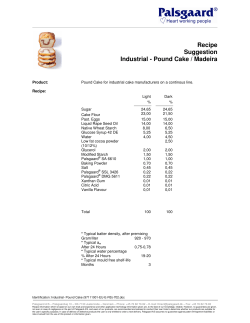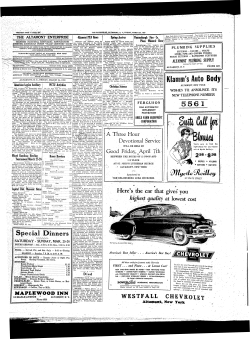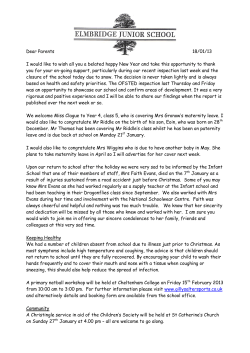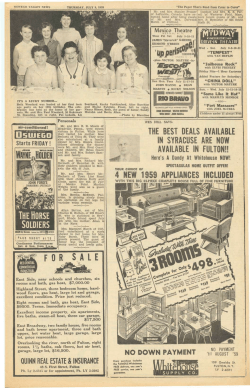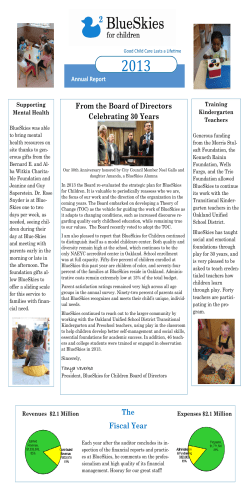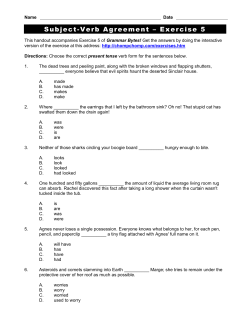
TRIFLE THE ENGLISH KITCHEN
THE ENGLISH KITCHEN TRIFLE Trifle, based on an illustration in Mrs Beeton, 1861. THE ENGLISH KITCHEN TRIFLE Helen Saberi and Alan Davidson prospect books 2009 Published in this form in 2009 by Prospect Books, Allaleigh House, Blackawton, Totnes, Devon TQ9 7DL. Trifle was first published by Prospect Books in 2001. © 2001, Helen Saberi and the estate of Alan Davidson. The authors assert their right to be identified as the authors in accordance with the Copyright, Designs & Patents Act 1988. British Library Cataloguing in Publication Data: A catalogue entry for this book is available from the British Library. No part of this publication may be reproduced, stored in a retrieval system or transmitted in any form or by any means, electronic, mechanical, photocopying, recording or otherwise, without the prior permission of the copyright holders. ISBN 978-1-903018-72-9 The cover is the composition ‘Trifle’ by Ali Roscoe. The photograph taken by Clare Pawley. Those illustrations in the text which are based on material from Mrs Beeton and Theodore Garrett are by James Stewart. Typeset in Hoefler Text by Tom Jaine. Printed and bound in Great Britain by the Cromwell Press Group, Trowbridge, Wiltshire. ACKNOWLEDGEMENTS O ur first thanks go to our respective spouses, Jane Davidson and Nasir Saberi, both of whom have been called on to tolerate invasions of kitchen space by great clutters of ingredients and equipment for testing recipes, and whose comments have been consistently helpful. Next we thank our publisher Tom Jaine, for encouraging our project and waiting with great patience for the little book to be completed. Many other people have given us valuable help. Some kindly sent us recipes; some graciously allowed us to reproduce recipes or texts of which they had the copyright and some provided pertinent information and helpful ideas. Their generosity has been remarkable and is evidence of how strongly the subject of Trifles appeals to all. Here is a list of these kind people, with our warm thanks to all of them for their support, given in many and various ways. We also express our gratitude to all the other authors mentioned in the text, or the bibliography, as sources of inspiration or practical information. Myrtle Allen, James Bishop, Shirley Lomax Brooks, Catherine Brown, Ann and Helen Caruana Galizia, Lesley Chamberlain, Jack Conte, Ivan Day, Fuchsia Dunlop, Ove Fosså, Svein Fosså, Brenda Garza Sada, Sophie Grigson, Hilary Hyman, Philip and Mary Hyman, Phil Iddison, Peter James-Smith, Tom Johnstone and the Estate of F. Marian McNeill,* Maria Kaneva-Johnson, Rachel Laudan, Helen Leach, Gilly Lehmann, Margaret Little, Fiona Lucraft, John Mariani, Laura Mason, Jill Norman, Mary Norwak, Henry Notaker, Marguerite Patten, Chris Payne, Alicia Rios, Nanna Rögnvaldardóttir, Françoise Sabban, Barbara Santich, Marta Scheffer, Ann Semple, Regina Sexton, Catherine (Sheridan) Tingley, Maria Dolores Torres Yzábal, Olivia Warren. * In expressing our thanks to the Estate, we are asked to point out that the current (Mercat Press) edition of Marian McNeill’s The Scots Kitchen (see page 53), is a facsimile of the first 1929 edition, so does not contain the recipe which we have taken from the 1963 edition. FAST TRACK GUIDE T here are over ninety recipes for trifle in this book, some of them included for historical reasons or as curiosities. Readers who are simply looking for something practical (or, alternatively, for something really exotic or challenging) can use this ‘fast track guide’ to recipes likely to suit them. quick and easy 1. 2. 3. 4. May Byron’s Countess Trifle, p. 41 Danish Raspberry Foam, p. 83 Grape and Ginger Syllabub, p. 104 Ratafia Trifle, p. 46 1. 2. 3. 4. Marian McNeill’s Scots Trifle, p. 53 Jane Grigson’s Banana Trifle, p. 56 Icelandic Ommutriffli, p. 85 Easter Trifle, p. 43 1. 2. 3. 4. 5. PPC Celebration Trifle, p. 61 Caramelized Orange trifle, p. 59 Trifle Belle Hélène, p. 58 Summer Syllabub, p. 58 A Sicilian Zuppa Inglese, p. 107 1. 2. 3. 4. 5. 6 traditional and guaranteed to produce a good result specially festive really Exotic Ante de Yemas, p. 75 Viceroy’s Dessert, p. 76 Eritrean Trifle, p. 90 Kabul Trifle, p. 112 Vientiane Trifle, p. 113 trifle TABLE OF CONTENTS Acknowledgements Fast Track Guide Introduction Using the Recipes Trifle Architecture 5 6 11 13 14 Chapter One – The Early Years 15–18 Thomas Dawson ✣ Jos Cooper ✣ Hannah Woolley ✣ John Evelyn ✣ Robert May ✣ Mrs Mary Eales Chapter Two – British Trifles 1750 to 1800 19–28 First appearance of Trifle as we know it ✣ Hannah Glasse; Floating Island, Trifle of 1751 ✣ Mrs Powell ✣ Sister Nanny ✣ The Lady’s Companion (2 recipes) ✣ Hannah Glasse, A grand trifle ✣ Mrs Cleland ✣ Martha Bradley ✣ Elizabeth Raffald ✣ Sarah Mason ✣ Mrs Maciver ✣ Mrs Frazer Chapter Three – Trifles in Nineteenth-Century Britain 29–38 Mrs Rundell; An excellent trifle, Indian Trifle, Chantilly Cake, or Cake Trifle ✣ Family Receipt Book, A Grand Trifle ✣ Meg Dods, An Elegant Trifle ✣ Eliza Acton, An Excellent Trifle and Very Superior Whipped Syllabubs ✣ A Steeped Cake ✣ Cre-Fyyd, Gooseberry Trifle ✣ Theodore Francis Garrett, Queen of Trifles ✣ Mrs Roundell, Trifle (Family Recipe) Chapter Four – British Trifles in the First Half of the Twentieth Century 39–48 Mrs de Salis, Trifle à la Old Century ✣ May Byron; Countess Trifle, Pear Trifle, Lemon Trifle ✣ Violet Farebrother, An Easter Trifle ✣ “Angostura” Trifle ✣ Mrs Leyel and Olga Hartley, The Writer’s Special Trifle ✣ Apple Snow Trifle ✣ More Favourite Puddings of Rural England, Ratafia Trifle ✣ Irene Veal with a trifle recipe from Reginald Foort ✣ Mrs Kirk, Trifle trifle 7 Chapter Five – British Trifles from 1950 Onwards 49–63 Views of Elizabeth David ✣ Marguerite Patten; Trifle, Jelly Trifle ✣ Helen Cox, English Trifle ✣ Marian McNeill, Scots Trifle ✣ Comments by Myrtle Allen ✣ Monica Sheridan, Visitors’ Trifle ✣ Jane Grigson, Banana Trifle ✣ Summer Syllabub Trifle ✣ Trifle Belle Hélène ✣ Caramelized Orange Trifle ✣ PPC Celebration Trifle Chapter Six – Trifle in the New Worlds 64–78 Mary Randolph’s Trifle (USA) ✣ Mrs Hill’s Trifle and Gipsy Squire (USA) ✣ Marion Harland’s Peach Trifle (USA) ✣ 200 Years of Charleston Cooking, Trifle (USA) ✣ Ida Lupino as a trifle maker (USA) ✣ Quotation from M.F.K. Fisher (USA) ✣ Ladies of Toronto’s Fig Trifle with Almond Custard (Canada) ✣ Lemon Trifle (Australia) ✣ Tango Trifle (Australia) ✣ Trini Tropical Trifle (Trinidad) ✣ Ante de Yemas (‘Mexican Trifle’) ✣ Viceroy’s Dessert (Mexico) ✣ Sopa Inglesa (Argentina) Chapter Seven – Trifles Elsewhere 79–94 Jules Gouffé’s Mousse à l’Anglaise (France) ✣ Plettenpudding (Germany) ✣ Hindbærskum med Frugtliker (Raspberry Foam – Denmark) ✣ Tilslørte Bondepiker (Veiled Maidens – Norway) ✣ Ommutriffli (Grandmother’s Trifle – Iceland) ✣ Anyóstorta (Mother-in-Law’s Torte – Hungary) ✣ Dr Riddell’s Trifle (AngloIndian) ✣ Snow Eggs for Trifles ✣ Egg-Snow Trifle ✣ The Gulf and the Horn of Africa ✣ Eritrean Trifle ✣ South African Trifles ✣ Hildagonda J. Duckitt’s Trifle (and pencil) Chapter Eight – Trifling Relations 95–104 Whim-ham – Hannah Glasse ✣ Whim-wham – Mrs Dalgairns ✣ Tipsy Cake, or Brandy Trifle (Eliza Acton) ✣ Hedgehog Tipsy Cake (Florence White) ✣ Tipsy Cake Pudding (Lucy Jones) ✣ Tipsy Pudding (Wyvern) ✣ Wassail Bowl (Meg Dods) ✣ Swiss Cream, or Trifle (Eliza Acton) ✣ The Dean’s Cream (Florence White) ✣ White Grape and Ginger Syllabub 8 trifle Chapter Nine – Italy: Zuppa Inglese and Tiramisu 105–110 Zuppa Inglese ✣ A Sicilian Zuppa Inglese ✣ Tirami Sù Chapter Ten – Oddities 111–117 Cold Savoury Trifle (Theodore Francis Garrett) ✣ Beef Trifle (The ‘Pudding Lady’) ✣ Kabul Quince and Yoghurt Trifle ✣ Vientiane Coconut Jelly Trifle ✣ London Trifle ✣ Soufflé (Maltese Trifle) ✣ Aphrodisiac Trifle Glossary of Trifling Terms Bibliography Measures: Tables of Equivalence trifle 118–126 127–131 132–133 9 This attractive drawing by Juliet Stanwell Smith served as the keynote illustration for the chapter on ‘Tipsy Cakes and Trifles’ in Mary Norwak’s charming and authoritative book English Puddings, Sweet and Savoury (Batsford, London, 1981). Reproduced here by kind permission of Mary Norwak, it serves equally well to complement the Introduction to our own book, by displaying in an English countryside setting a panoply of members of the trifle family (including a baked trifle on the left, what are probably whim-whams at the back, a tipsy cake hedgehog on the right, and of course a mainstream traditional trifle in the foreground). 10 trifle P INTRODUCTION reparing this book has been a delightful experience for both of us. During the long years when we were toiling away to gether on the massive Oxford Companion to Food we often thought how refreshing it would be, when that was finished, to switch to some small, light project. And what better topic for this than the trifle, ‘a thing of no consequence’, ‘something light and frothy’. The project had its pilot: a major essay, introduced by Alan, which Helen contributed to the special 50th issue of the journal PPC. A quotation from what each of us wrote then will show with what lively interest we approached the subject. Alan observed that: ‘One of the great paradoxes of culinary terminology is that what many people see as Britain’s supreme contribution to the dessert tables of the world, for children and adults alike, to wit the trifle, should bear a name which suggests that it is of no consequence. This, surely, is carrying much too far the British tradition of playing down the merits of things British.’ Urging that due tribute should be made to this essentially British confection, he added that: ‘in cottage and castle alike this plebeian yet aristocratic, complex yet simple, creation achieves a degree of satisfaction for human appetites and an aesthetic and emotional impact which stand unrivalled on the tablecloth.’ Helen wrote: ‘Trifles offer a rare combination of sensual and intellectual pleasures. How many times have I dipped my spoon into one and experienced in succession the light frothy cream, the smooth velvety custard, the tangy fruit mingling with the bouquet of wine (or sherry or liqueur), and perhaps a touch of almondy crunchiness from ratafias or macaroons, and lastly the sweet, soft but crumbly texture of the sponge or sponge fingers. Mmm, the very thought sets me off. But this literal dipping of the spoon can be matched on the intellectual side by delving trifle 11 into the successive layers of the history of the trifle, with a pleasure almost as intense. ... I have made trifle many times over many years and always with real enjoyment – a trifle with its carousel of flavours, colours and textures is so easy to make.’ With this twofold testimony to our enthusiasm, we introduce this book, a real labour of love. In it we seek not only to provide a panoply of well tested recipes (ah, happy days when we had two trifles a week to sample and discuss over lunch!), and to describe the history and essential nature of the trifle in its homeland, but also to exhibit relations of the trifle in other continents, showing the degree of biodiversity which this dish has achieved. Diversity? Yes, we know that The New Shorter Oxford English Dictionary defines the current meaning of trifle, in a culinary context, quite precisely and narrowly: ‘Now a dessert of sponge cake (esp. flavoured with sherry or spirit) with custard, jelly, fruit, whipped cream etc.’ But in fact variations on the trifle theme – all delicious – seem to us to be just about as infinite as the stars in the sky. And we should not overlook the last word of the NSOED definition. That little ‘etc.’ covers a multitude of things (yes, ‘hundreds and thousands’ one might say, if tempted by a play on words). Now, we wish our readers as much pleasure in using the book and eating trifles as we have had in preparing the book (and of course eating trifles ourselves). The pleasure for us was all the greater, because, thanks to the generosity of Jane Davidson, we were able to compose the book in ideal surroundings, a courtyard complex in Chelsea, built in 1885 by Elijah Hoole to provide accommodation and a garden for 60 labourers. The driving force behind the project was Lady Kate Courtney (died 1929, after many decades of beneficent activities in Chelsea). It is to her memory that we dedicate this book. Alan Davidson and Helen J. Saberi The Porticos, King’s Road, Chelsea December 2000 12 trifle A USING THE RECIPES ll the recipes have been carefully tested, except for certain old ones which are given verbatim from the original source. We felt that in many instances readers would prefer just to see for themselves what, say, Mrs Raffald wrote in the eighteenth century, without the comments, substitutions and adaptations which are the almost inevitable result of testing. It is difficult to think of any trifle recipe whose instructions should be treated as sacrosanct. Almost all contain ingredients which can be substituted by something else without detriment. u Thus ‘sponge cake’ takes many forms, any of which will do, and other plain cake may be just as effective. u No-one need feel bound to use Madeira wine if it is more convenient to use Malaga or Sherry. u A specified fruit or jam can often be replaced by another (peach for apricot, strawberry for raspberry), although it would be inappropriate to use a substitute for gooseberry or banana if these fruits were principal ingredients. u The whole field of decorations (candied petals, angelica, hundreds and thousands, etc.) for the top of a trifle is wide open to whatever variations appeal. Thickness of layers, amounts of whipped cream or syllabub, dosage of an alcoholic drink (if used), etc. – all may be varied. A table of equivalent weights and measures is provided at the end of the book. This provides only the information which is relevant to the recipes in this book. Here again, flexibility is in order. For example, if a recipe calls for ‘cups’, you can normally use either Imperial or American, so long as you stick to one kind of cup throughout any given recipe. The same applies to pints. In choosing a recipe, readers may find it especially helpful to consult the Fast Track Guide (p. 6) and to browse through the Table of Contents, specially enhanced for this purpose. Readers who still find difficulty in choosing among our ninety or so recipes may like to reflect on the difficulties we had in choosing from the many hundreds we have examined. trifle 13 TRIFLE ARCHITECTURE T he construction of a trifle – anyway, a trifle on a domestic scale – does not call for the use of cranes or excavators and mechan ical spreaders, but it does exemplify the application of some principles which apply to the construction of buildings. As with a building, so with a trifle – the foundations are very important. Where the building would be set on compacted rubble, the trifle starts at the bottom with its layer of moist compacted sponge (and macaroons or whatever), bound by jam to prevent disconcerting shifts as the weight above is increased. For those who admit a layer of jelly, this will replace the uneven surface of the ‘rubble’ with a solid sheet of load-bearing substance – the counterpart of a screeded concrete floor. Otherwise a custard which has set firmly will fill this role, instead of sitting on top of the jelly. In this connection, and on the assumption that the top of the trifle is to be decorated, then special attention must be paid to the loadbearing capacity of the topping, for example, the whipped cream or syllabub. There are many variables here, of which the trifle decorator should be mindful. One is the ‘footprint’ of any given piece of decoration. If this is very small, as in the case of one of the tiny ‘hundreds and thousands’ which are sometimes used, then it will penetrate the topping at a relatively high speed, even if its weighs little. If, on the other hand, the footprint is quite large, as in the case of a thin flat strip of candied angelica, it will stay in place for longer. Candied flower petals are quite good in this respect, and they also have an advantage in being very light weight. To state the obvious, the heavier a decoration is the faster it will sink. Another variable is the stiffness of the whipped cream (or whatever); the stiffer the better for holding up decorations. The depth of the layer of whipped cream and the diameter of the bowl are also relevant; take special care if the depth is very great. And, since the ambient temperature will also have an effect, chill a decorated trifle before serving. 14 trifle chapter one THE EARLY YEARS I t would be pleasant to think that it was a contemporary of Shakespeare, and the author of what has been described as the finest Tudor cookery book, who was the first to bring into print a recipe for making a trifle, that most English (or rather British) of sweet and festive dishes. And so it would seem. Thomas Dawson, author of the book in question (The Good Huswife’s Iewell, 1596) gives a recipe which is clearly headed ‘To make a Trifle’. However, his text, which is reproduced below, does not describe anything like the trifle which has been familiar to us for well over two centuries, but seems rather to be a recipe for a Fool (see the Glossary). To make a Trifle Take a pinte of thicke Creame, and season it with Sugar and Ginger, and Rosewater, so stirre it as you would then have it, and make it luke warme in a dish on a Chafingdish and coals, and after put it into a silver piece or bowle, and so serve it to the boorde. What little is known about Dawson, and the speculations which have plausibly been made by Maggie Black (in her introduction to the 1996 edition of his book) suggest that he was a man of considerable gifts, well practised in kitchen arts even if not a professional cook. It may therefore be taken as definite that at the end of the sixteenth century something called trifle but more like a fool did exist. This is supported by the NSOED which tells us that originally in the late sixteenth century, the culinary meaning of the word trifle was ‘a dish composed of cream, boiled with various ingredients’, i.e. not far removed from what we call a fool, which nowadays is usually a fruit purée and cream combined. Indeed Florio, in his dictionary of 1598, bracketed the two terms when he wrote: ‘a kind of clouted cream called a foole or a trifle.’ the early years 15 Books which appeared in the seventeenth century and the early part of the eighteenth corroborate this. The fool/trifle seems to have been an established item for nearly two centuries. The convergence of the two terms at that time is well exemplified in the next book on our list, The Art of Cookery Refin’d by Jos Cooper, dated 1654 and of exceptional interest for reasons explained by Louise A. Richardson and J.R. Isabell (1984). His recipe is entitled ‘To make a Foole’, although in fact it comes a little closer, by incorporation of slices of bread at the bottom of the dish, to the modern trifle. To make a Foole Slice a Manchet [loaf of fine bread] very thin and lay it in the bottom of a dish; and wet them with Sack; boyle Creame, with Eggs, and three or foure blades of Mace; season it with Rosewater and Sugar, stir it well together to prevent curd ling; then pour it on the Bread and let it coole; then serve it up to the Table. Many more examples could be given from later authors including Hannah Woolley, in The Lady’s Closet (or Queen-Like Closet) of 1672 (5th edn. 1684). Her recipe does illustrate two new developments. It includes rennet; which produces a ‘set’ rather than a liquid confection. It is also the first trifle recipe to provide for using comfits (see Glossary). To make a Trifle Take Sweet Cream, season it with Rosewater and Sugar, and a little whole Mace, let it boil a while, then take it off, and let it cool, and when it is lukewarm put it into such little Dishes or Bowls as you mean to serve it in; then put in a little Runnet, and stir it together; when you serve it in, strew on some French Comfits. One of the most famous Englishmen of the seventeenth century, John Evelyn, also had a recipe for this sort of ‘trifle’, which appears in the collection of his manuscript recipes edited by Christopher Driver. 16 trifle A trife Take some creame and boyle it with Cinnamon and mace take out the spice when it is boyled sweeten the cream with some fine sugar put in a spoonful or 2 of Rose water and when it is allmost cold put in as much rennet as will bring it to a tender curd. And Robert May, whose book The Accomplisht Cook (1685 edn.) is the finest and fullest cookery work of the century, conforms. Triffel Take a quart of the best and thickest cream, set it on the fire in a clean skillet, and put to it whole mace, cinnamon, and sugar, boil it well in the cream before you put in the sugar; then your cream being well boiled, pour it into a fine silver piece or dish, and take out the spices, let it cool till it be no more than blood-warm, then put in a spoonful of good runnet, and set it well together being cold scrape sugar on it, and trim the dish sides finely. Mrs Mary Eales (1718), the self-proclaimed ‘Confectioner to the late Queen Anne’, has a trifle which is similar to May’s, except that she adds orange flower water instead of cinnamon and mace; and she says specifically, after the rennet had been put in, ‘let it stand ’till it comes like Cheese’. This gives a clear impression of the consistency which a trifle was expected to have in that time. To make a TRIFLE Take a Pint of Cream, and boil it, and when it is almost cold, sweeten it, and put it in the Bason you use it in; and put to it a Spoonful of Runnet; let it stand ’till it comes like Cheese: You may perfume it, or put in Orange-Flower-Water. So far as we can ascertain, the prescription of Mrs Eales was followed by three decades of silence. Yet it was during these three decades that someone, somewhere, created what we know as a trifle and, perhaps for lack of a better alternative, transferred to it the name which had for so long belonged to a category of fools. the early years 17 A facsimile of Mrs Mary Eales’s receipt for trifle, the edition of 1733. 18 trifle
© Copyright 2025

